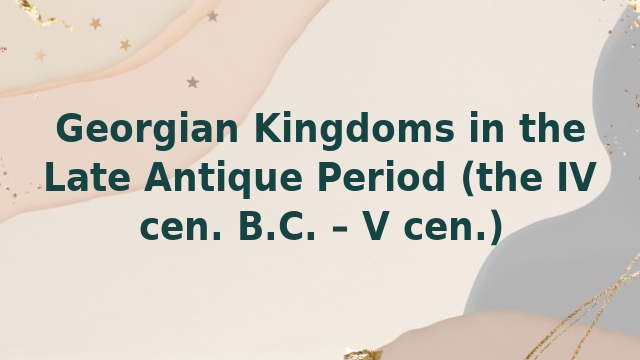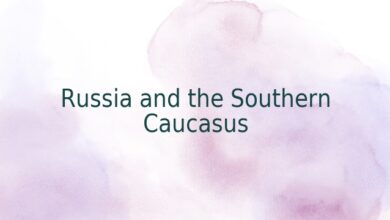
There were several early-state creations of Georgian tribes on the modern Eastern territory of Georgia in the IV cen. B.C. and they had permanent struggles for the leadership. In this struggle won the union, the center of which was town Mtskheta, existing at the mouth of the Rivers Mtkvari and Aragvi. Mtskheta existed on a very useful place – in the junction of the roads from the Caspian Sea to the Black Sea, and from the East Europe to Front Asia, that helped the fast development of the town.
At the end of the IV cen. B.C. the representative of Mtskheta aristocracy – Parnavaz, unified the territory from the Caucasus Range till the source of the River Euphrates, and got the title of King. Thus was created the unified Eastern Georgian Kingdom – Iberia (Kartli in Georgian). Mtskheta became the capital of this Kingdom, and the residence of the Kings of Iberia was the citadel on the high mountain opposite to Mtskheta – Armaztsikhe.
Iberia, or Kartli, was a rich, densely inhabited country. According to the natural conditions, it consisted of two zones – highland and lowland. The population of the highland mainly was occupied with cattle-breeding, and the population of the lowland – with agriculture. The highlanders were distinguished by being warriors and played a big role in the military organization of Iberia.
In the cities of Iberia there lived merchants and handicraftsmen, but the important part of them was of the foreign origin – mainly Jews and Syrians.
In the religious life of Iberia there were many things remained from the Tribal System Age. They worshiped the God of Fertility and the Devines of Thunder and Heavenly Bodies. There existed the remainders of Totemism. From the Parnavazi period at the head of Pantheon stood the God of Moon – Armazi, the idol of which stood near Mtskheta, on the top of one of the mountains. Armazi expressed a cruel warrior, with an armour and a sword in his hand.
In a Foreign Policy, Parnavazi and his closest inheritors took their bearings to the union with Selevkides, but in the II cen. B.C. international condition aggraviated for Iberia. In the South, the country lost several important districts, which were cut off by the new-created Armenian Kingdoms, and in the West, the neighbour of Iberia became the Ponto Kingdom, the King of which, Mithridate VI, annexed Kolkhida to his domain. During the Wars of Mithridate, Iberia was his ally against Rome, that became a reason for invasion of a famous Roman General – Pompeus, on its territory in 65 y. B.C. Pompeus defeated the army of Artag, the King of Iberia in a big struggle, but faced a wide-spread public resistance, which forced him to hasten a conclusion of peace with Artag. According to the Pax, Iberia became an ally of unequal rights to Rome. After that Romans entered Kolkhida and conquerred this country too.
In the I-II cen. the Iberian Kingdom strengthened again, that was a result of economical rise of the country. Agriculture, handicraft, trading developed. The territory of Iberia was crossed by a big trade way from India to Greece.
The strengthening of Iberia at first was profitable for Romans, because in their Eastern Policy they often used the Iberian Allies. Besides, Iberia controlled the most important Passes of Central Caucasus, by which it protected the Asian domains of Rome from the invasion of the warrior tribes from the Northern Caucasus. But the strengthened Iberia gradually began to run its independent foreign policy. The King Parsman I (the I cen.) used the opposition between Rome and Partia and possessed Armenia, the King of which became at first his brother and then his son. In the I-II cen. the territory of Iberia widened. It got back its lost Southern provinces.
In the II cen. the condition in Kolkhida was characterized with the new political realities. In its sea-coast zone there were created Western Georgian and Abkhazian tribal Principalities – Lazika, Apsilia, Abazgia, Sanigia, the governors of which recognized the supremacy of Roman Emperors.
In the III cen. the foreign-political situation of Iberia aggraviated again. The main object of the expency of the dominion in Iran, new Persian dynasty – Sasanides, became Transcaucasus, that forced Iberia to stand firmly with the Rome orientation again and to oppose Iran. The one of the expression of that was a declaration of Christianity as a state religion of Iberia, which happened approximately in 337. As it appears, in the IV cen. Christianity was established in Kolkhida as well, where at that time was a tendency of unity. For instance, the principality of one of the Western Georgian (Zanian) tribes, Lazis – Lazika (Egrisi in Georgian), spreaded its influence on other local political units and tribes. The strengthened Kings of Lazis quited from submission of Rome too.
In Iberia, development of Christianity gave a strong jerk to the development of Georgian writing. The oldest Georgian writings, kept until now, which are written by an original script, are dated the V cen.
In the IV-V cen. there was a process of establishing feudal relations in Georgia. This period is a difficult foreign-political condition for Iberia. The union with Romans couldn’t protect the country from the aggression of Sasanides, which especially became stronger from the first half of the V cen. when Persians conquerred the neighbouring countries of Iberia – Armenia and Albania and came to the borders of East Georgia. The Wars between Georgians and Persians began. Especially must be noted the second half of the V cen. when the King of Iberia was Vakhtang Gorgasali. The King Vakhtang was a good warrior, clever and vigorous governor. He tried to unify the people of Transcaucasus against Sasanides. In this way, he had a success. In his period Iberia strengthened again and annexed several neighbouring territories. Vakhtang Gorgasali also held a big constructing activity too. Founding Tbilisi as a city is related to his name, which was only a fortress before. But in the beginning of the VI cen. Vakhtang Gorgasali was killed in the struggle against Persians.
by Dr. George Anchabadze





